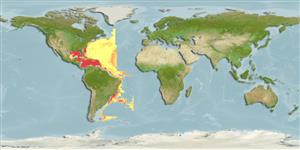Common names from other countries
>
Gadiformes (Cods) >
Macrouridae (Grenadiers or rattails)
Etymology: Hymenocephalus: Named for its transparent membrane-like head covering (‘‘hymen head’’) and fragile nature of head bones (Ref. 100825).
More on authors: Marshall & Iwamoto.
Environment: milieu / climate zone / depth range / distribution range
Ekologi
laut batipelagis; kisaran kedalaman 400 - 900 m (Ref. 37108). Deep-water
Western Central Atlantic: Straits of Florida, Gulf of Mexico, Caribbean Sea, and off Rio de Janeiro, Brazil.
Size / Weight / umur
Maturity: Lm ? range ? - ? cm
Max length : 39.5 cm TL jantan/; (Ref. 115012); Berat maksimum terpublikasi: 270.90 g (Ref. 115012)
duri punggung lunak (Keseluruhan (total)) : 10 - 13. This species is distinguished by the following characters: pelvic fin rays 12-14 (usually 13-14); pectoral fin rays 14-17; projecting snout, 20-25% HL; short barbel, 4-5% HL, does not reach vertical through anterior margin of orbit; moderate orbit diameter, 28-35% HL; infraorbital width 12-15% HL; moderately long preopercular supporter, with angle at rear margin, 5-6% HL; 23-28 gill rakers; ventral striae reaching to ½ to ? distance from pelvic fin bases to periproct; otolith has moderately high predorsal lobe, with colliculi separated, closely placed across collum, terminating at some distance from anterior and posterior rims of otolith; otolith length to height (OL:OH), 1.05; total colliculum length to pseudocolliculum length (TCL:PCL), 2.6-2.8 (Ref. 98298).
Life cycle and mating behavior
Maturities | Reproduksi, perkembang biakan | Spawnings | Egg(s) | Fecundities | Larva
Cohen, D.M., A.W. Ebeling, T. Iwamoto, S.B. McDowell, N.B. Marshall, D.E. Rosen, P. Sonoda, W.H. Weed III and L.P. Woods, 1973. Fishes of the western North Atlantic. Part six. New Haven, Sears Found. Mar. Res., Yale Univ. (Ref. 37108)
Status IUCN Red List (Ref. 130435)
CITES (Ref. 128078)
Not Evaluated
ancaman kepada manusia
Harmless
penggunaan manusia
Alat, peralatan
laporan khas
muat turun XML
Sumber internet
Estimates based on models
Preferred temperature (Ref.
115969): 7.1 - 13.9, mean 9.5 (based on 83 cells).
Phylogenetic diversity index (Ref.
82804): PD
50 = 0.5000 [Uniqueness, from 0.5 = low to 2.0 = high].
Bayesian length-weight: a=0.00145 (0.00087 - 0.00240), b=3.20 (3.05 - 3.35), in cm Total Length, based on LWR estimates for this species & (Sub)family-body (Ref.
93245).
Trophic level (Ref.
69278): 3.5 ±0.4 se; based on size and trophs of closest relatives
Daya lenting (Ref.
120179): sedang, Waktu penggandaan populasi minimum 1.4 - 4.4 tahun (Assuming tmax>3).
Fishing Vulnerability (Ref.
59153): Low to moderate vulnerability (30 of 100).
